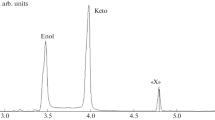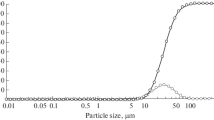Summary
The resolution of amino acid enantiomers by gas chromatography on optically active stationary phases has been explained by the formation of hydrogen bonded diastereomeric association complexes. Structural considerations involving these complexes have led to the synthesis of a new phase, TFA-L-valyl-L-leucine cyclohexyl ester. Relative retention times and resolution factors have been determined for each enantiomeric pair of eleven amino acids and glycine. Investigations have uncovered some trends in resolution factors and relative retention times for amino acids on different dipeptide phases. These patterns led to an explanation for the difficulties found in resolving D, L-proline. Structural differences about the α-carbon in the dipeptide phase influence the elution pattern of TFA-amino acid isopropyl esters from the column. Particularly strong effects are found in the elution patterns of hydroxy amino acids on different dipeptide phases.
Zusammenfassung
Die Trennung von Aminosäure Enantiomeren mit Hilfe der Gas-Chromatographie an optisch aktiven stationären Phasen ist durch die Ausbildung von diastereomeren Anlagerungskomplexen, die durch Wasserstoffbrücken gebildet werden, erklärt worden. Strukturelle Betrachtungen dieser Komplexe haben zur Synthese einer neuen stationären Phase, TFA-L-Valyl-L-leucincyclohexylester, geführt. Relative Retentionszeiten und Trennfaktoren sind für jedes Enantiomerenpaar von elf Aminosäuren und Glycin bestimmt worden. Die Untersuchungen haben einige Hinweise auf die Trennfaktoren und relativen Retentionszeiten für Aminosäuren an verschiedenen Dipeptidphasen ergeben. Diese führten zu einer Erklärung der Schwierigkeiten, die auftreten, wenn man D, L-Prolin auftrennen will. Strukturelle Unterschiede am α-Kohlenstoffatom in den Dipeptidphasen beeinflussen das Elutions diagramm der TFA-Aminosäureisopropylester von der Säule. Besonders starke Effekte werden in den Elutionsdiagrammen der Hydroxy-aminosäuren an verschiedenen Dipeptidphasen gefunden.
Résumé
La séparation des antipodes optiques des aminoacides par chromatographie en phase gazeuse sur des phases fixes optiquement actives a été expliqué par la formation de complexes d'association entre diastéréoisomères par liaisons hydrogène. Des considérations de structure sur ces complexes ont abouti à la synthèse d'une nouvelle phase fixe, l'ester cyclohexylique de la TFA-L-valyl-L-leucine. Les temps de rétention relatifs et les facteurs de résolution ont été déterminés pour chaque paire d'antipodes optiques de onze amino-aides et pour le glycocolle. Les études ont fait apparaîre certaines relations entre les facteurs de résolution et les temps de rétention relatifs pour les amino-acides sur différentes phases fixes du type dipeptide. Ces relations ont permis d'expliquer les difficultés qu'on rencontre lors de la séparation de la D-proline de la L-proline. Des différences de structure autour du carbone-α dans la phase fixe du type dipeptide peuvent modifier le diagramme d'élution des esters isopropyliques de TFA-amino-acides. On trouve des influences particulièrement marqués de la structure sur le dia gramme d'élution des hydroxy-amino-acides pour différentes phases fixes du type dipeptide.
Similar content being viewed by others
References
Feibush, B. andGil-Av, E., Tetrahedron Letters 3345 (1967), Tetrahedron26, 1361 (1970).
Gil-Av, E., Feibush, B. andCharles-Sigler, R., “Chromatography 1966”, A. B. Littlewood, Ed., Institute of Petroleum London 1967, p. 227.
Nakaparksin, S., Birrell, P., Gil-Av, E. andOró, J., J. Chromatog. Sci.,8, 177 (1970).
Koenig, W. A., Parr, W., Lichtenstein, H. A., Bayer, E. andOró, J., J. Chromatog. Sci.8, 183 (1970).
Parr, W., Pleterski, J., Yang, C. andBayer, E., in “Advances in Chromatography 1970”, edited by A. Zlatkis, Chemistry Department, University of Houston, 277 (1970), and J. Chromatog. Sci.,9, 141 (1971).
Parr, W., Yang, C., Bayer, E. andGil-Av, E., in “Advances in Chromatography 1970”, edited by A. Zlatkis, Chemistry Department, University of Houstone, 287 (1970), and J. Chromatog. Sci.8, 591 (1970).
Parr, W., Yang, C., Pleterski, J., andBayer, E., J. Chromatog.50, 510 (1970).
Koenig, W. andGelger, R., Chem. Ber.103, 788 (1970).
Author information
Authors and Affiliations
Rights and permissions
About this article
Cite this article
Parr, W., Howard, P. Separation of amino acid enantiomers by gas chromatography with an optically active stationary phase (N-TFA-L-valyl-L-leucine cyclohexyl ester). Chromatographia 4, 162–166 (1971). https://doi.org/10.1007/BF02270615
Received:
Accepted:
Issue Date:
DOI: https://doi.org/10.1007/BF02270615




